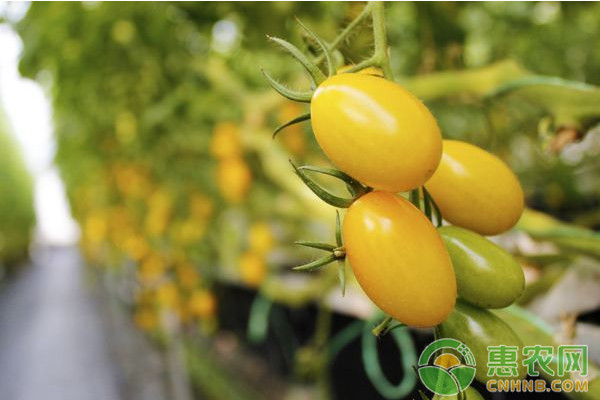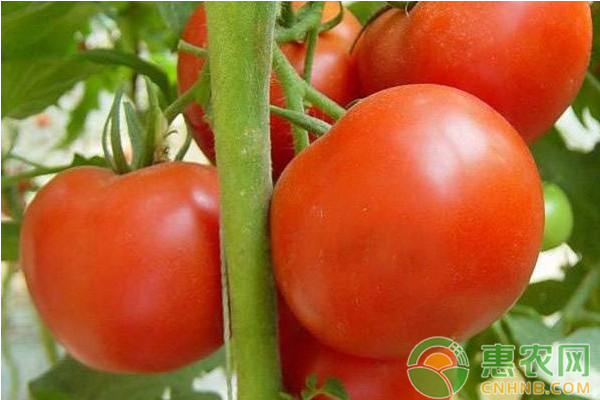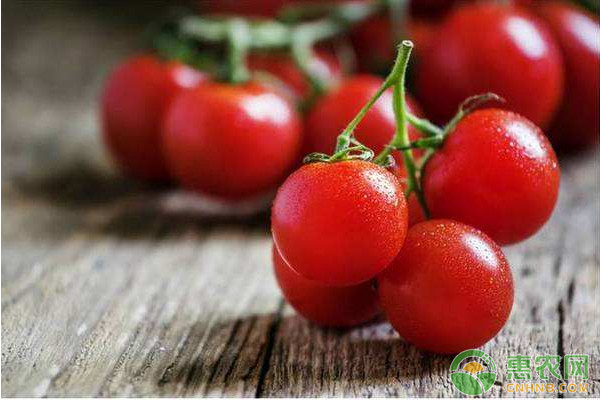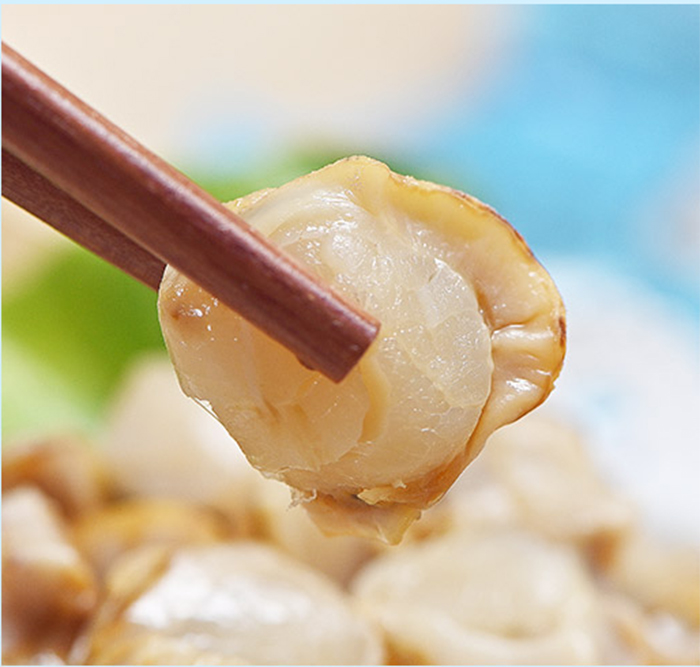Huangyan tomato is another major geographical indication of Huangyan, and its taste is tender and juicy. Today, Hui Nongwang Xiaobian wants to talk to you about the technical points of the anti-season yellow rock tomato greenhouse cultivation. 1 disease 1.1 medullary necrosis 1.1.1 illness In the early stage of the disease, the young leaves are chlorotic, the upper part of the plant is chlorotic and wilting, accompanied by the necrosis of the lower stem. The surface of the diseased stem is brown to dark brown spots on the surface, and the outer part is hardened. The stem of the longitudinal section can be seen to become black or necrotic. Vascular bundle browning, these lesions occur in the place where there is no lesion outside the plant, and many adventitious roots grow in the place where the lesion occurs in the pith. When the lower stem is infected, it often causes the whole plant to die. When the humidity is high, the bacterial pus overflows from the stem wound and the adventitious root, which is different from the ulcer disease. 1.1.2 Incidence conditions Pathogenic bacteria are initially present on tomatoes and alfalfa, often occurring from the first fruit set to the mature green fruit stage, and the distribution of the disease in the field is random. It is easy to occur under low night temperature, high nitrogen and high humidity conditions. 1.1.3 Control measures 1 Apply compost or fully decomposed organic fertilizer, and use formula fertilization technology to avoid excessive application of nitrogen fertilizer. 2 Avoid high humidity conditions. 3 In the early stage of the disease, the bacteria must be 300 times liquid, 3 to 4 times a day, and even sprayed 3 to 4 times, which can be controlled after the disease, and the initial occurrence can be restored. 1.2 Fusarium wilt 1.2.1 illness Fusarium wilt is a soil-transmitting vascular bundle disease that is difficult to control, often associated with bacterial wilt. Most of the disease occurs in the flowering stage, which often causes the plants to die in the fruiting stage. In the early stage of the disease, the middle and lower leaves of the plant wilted before and after noon, and recovered early and late. The symptoms of wilting gradually increased, and the leaves gradually turned yellow from bottom to top. Do not fall off until it dies. Sometimes it occurs only on one side of the plant, and the stems on the other side grow normally. The base of the stem is water-soaked close to the ground, producing pink, white or blue-green mildew when exposed to high humidity. Pull out the diseased plant and cut the base of the diseased stem. The vascular bundle turns brown. 1.2.2 Incidence conditions 1 continuous land, soil is sticky, acid, and there are many fields of Fusarium oxysporum accumulated in the soil. 2 The nematodes in the soil endanger the wounds caused by the roots of the tomatoes, which is conducive to the invasion of Fusarium. 3 seed bacteria, seedling soil, organic fertilizer and other bacteria may cause disease. 4 Plots with less phosphorus and potassium content and more nitrogen are more likely to develop. 5 soil temperature 27 ~ 28 ° C is the most suitable for this disease, too much soil moisture is conducive to the onset. 1.2.3 Prevention measures 1 In the early stage of the disease, 50% carbendazim 1000 times solution or carbendazim 800 times solution was used to irrigate the roots, 200 mL per plant, and the drug was administered once every 7 to 10 days, and then irrigated 2 to 3 times. 2 According to the "dry soil moisture and plant size" to determine the amount of drug, to "completely penetrate the distribution range of crop roots" for the purpose of generally 100 ~ 400mL per plant. 1.3 Leaf mold 1.3.1 illness It mainly harms the leaves and, in severe cases, also damages stems, flowers and fruits. After the onset of the leaves, chlorotic spots appear on the back of the leaves, and then a layer of gray, grayish purple, dark brown, grows. The front of the blade is light yellow with no obvious edges. The order of the disease is from the bottom to the top. The disease begins from the leaves. After the aggravation, the leaves of the whole plant are curled. The stems and stems of the stems are affected and spread to the flower parts. The fruits are not eaten. 1.3.2 Incidence conditions The most suitable climatic conditions for the disease are temperature 20~25°C and relative humidity above 95%. The relatively high temperature in the shed, the air circulation is not smooth, and the humidity is too large to cause the serious occurrence of the disease. 1.3.3 Control measures Before transplanting seedlings, use 45% chlorothalonil to disinfect indoors. In the early stage of the disease, timely use of drugs can be controlled by dust or smoke. The medicine can be used with 5% garnish dust and 45% chlorothalonil. Agent. Spray should be carried out in the morning, pay attention to the spray on the back of the leaf, you can choose 10% Shigao water dispersible granule 1000 times liquid, 2% Wuyimycin water 150 times liquid, 60% anti-mildew ultra-fine powder 600 times liquid, 47 % Garrinone wettable powder 600~800 times liquid spray, spray once every 7~8 days, even spray 3 times, pay attention to alternate medication to prevent drug resistance. When spraying, the vegetable farmers should pay attention to the key parts. The pathogen of leaf mold is to survive on the diseased body in the soil, and the tomato begins to develop leaf mold in the lower leaves of the plant. Tomatoes in the shed at the foot of the shed in the south are the first to occur. Therefore, it is important to spray the lower leaves of the plants and the plants on the south side of the greenhouse when spraying before the onset of the disease. Spraying drugs after the onset should focus on protecting the functional leaves in the upper part of the plant. 2 pests 2.1 Locust 2.1.1 Hazard characteristics The aphids that damage the solanaceous vegetables are mainly melons. It is often attached to the back of the leaf to suck the juice, and it can also be used in the young stem. After the damage, the leaves are curled up, and when the plants are severe, the plants stop growing. When the old leaves are damaged, they do not curl, but they dry out in advance. Aphids can spread a variety of viruses and are the main spreaders of tomato virus disease in greenhouses. 2.1.2 Control measures 1 spray 50% chlorpyrifos EC 2500 times solution, 20% chlorpyrifos (killing pyrethroid) emulsifiable concentrate 2000 times solution, 2.5% kungfu emulsifiable concentrate (pyrethyl ester) 3000~4000 times solution or 50% anti-Puwei WP Powder 2000~3000 times liquid, etc. 2 The smoker is suitable for preventing cockroaches in the protected area, 667m2 with 10% killing cockroach aerosol 0.5kg, or 10% fenvalerate aerosol 0.5kg. The application of aerosols is generally carried out at night, and piled up in the shed at various points. After being ignited, the closed greenhouses use smoke smoke to achieve insecticidal effects. After the next day of ventilation, enter the shed and operate. 3 The use of silver-gray plastic film has a repellent effect on aphids. 4 yellow plate lure. A yellow trap can be hung in the shed, and the mites tend to be yellow, and the traps are adhered to the board to have an insecticidal effect. 2.2 Helicoverpa armigera 2.2.1 Hazard characteristics Helicoverpa armigera has different effects on different organs of tomato. For mature fruit, only some of the flesh in the fruit is eaten, but the water will enter the pupil and cause ulceration. The young fruit is foraged first, then it is gradually hollowed out; After being harmed, the bracts open and then turn yellow. Also, some of the young shoots, young leaves and tender stems are eaten, often causing the stems to break. Once cotton bollworms occur in large numbers, the yield and quality of tomatoes are severely affected. 2.2.2 Prevention measures For the prevention and control of cotton bollworms, the most important thing is early prevention, early spraying, and continuous spraying. The so-called early spraying means that once a small amount of cotton bollworm is found, it is necessary to spray the medicine in time; continuous spraying means every 7 to 10 days. Spray once until the fruit matures. This can well control the hazards of cotton bollworms. At present, chemical control is mainly used. The production uses 800 to 1000 times of enemy killing, 5000% of Kungfu emulsifiable concentrate 5000 times or 10% of daisy emulsifiable concentrate 1500 times. Effect. 2.3 Comprehensive control measures 2.3.1 Reasonable rotation Rotating with non-solanaceae crops for more than 3 years to reduce the bacterial base in the soil. In the courtyard bridge, the farmers used the lettuce rotation 1, 2茬 after the tomato was continuously established for many years to achieve the purpose of reducing pests and diseases. 2.3.2 Seed disinfection The seed spores of the seeds can be killed by soaking seeds with warm soup or soaking the corresponding solution. 2.3.3 high temperature shack The tomato planters in the courtyard often use the high-temperature closed greenhouse in summer after the tomato is harvested in May. The temperature in the shed can be as high as 60 °C to achieve the purpose of soil disinfection. 2.3.4 Strengthening the management of the shed Through timely ventilation, drip irrigation and other measures to prevent high temperature and high humidity in the shed; timely pruning and smashing, removing the old leaf diseased leaves in the lower part of the plant; implementing formula fertilization to avoid excessive nitrogen fertilizer and appropriate application of phosphorus and potassium fertilizer. 2.3.5 Selection of resistant varieties 2.3.6 Use no drip film Remove the dust on the membrane in time, and properly plant it to facilitate ventilation and light transmission. The above is the whole content of the occurrence and control of pests and diseases in the anti-season cultivation base of Huangyan tomato greenhouse. Welcome everyone to continue to pay attention to Huinong.com to learn more about the cultivation techniques of special agricultural products.
The individual is full of flavor, fresh and tender meat, portable for traveling, and healthy ready-to-eat food.
Rich in unsaturated fatty acids, amino acids, taurine and many other nutritions It`s very good for human health.
How to eat :
Soaking dried scallop in clean water for 15 minutes until return to be natural soft
Cook,make soup or porridge
Original Scallop,Raw Scallops,Scallops In The Wild,Dry Scallops Shandong Haizhibao Ocean Science and Technology Co.,Ltd. , https://www.haizhibaoseafood.com



Prevention and control technology of main pests and diseases of Huangyan tomato in off-season greenhouse
Prev Article
Can Diabetes eat cool potato?